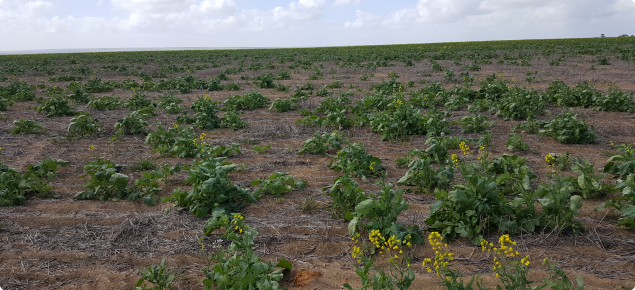Soil cover
- Low yield crops often have little biomass, and ground cover can be inadequate to prevent wind erosion over summer and the following autumn. See managing wind erosion in cropping for target stubble levels and management options to avoid erosion.
- If you intend to graze or spray out weeds in poor crops, leave it until just before the first weeds have viable seed. This will give the highest level of potential ground cover
- For guidance on the level of groundcover required, see Diagnosing wind erosion risk.
Grazing/slashing
- If possible, graze with your own/agisted stock to reduce the bulk of weed growth and delay seed set.
- Manage grazing to leave enough soil cover to prevent wind erosion.
- Slashing is another option but this machinery is limited/temperamental and is costly.
Herbicide options - using the double knock
- Weed seed set control may be a focus. The main option for most paddocks will be to use two sprays of knockdown herbicides in spring. The most common treatment used is likely to be glyphosate at 1.5–2L/ha. A spike of 2,4–D Ester 680 at 300–500mL/ha may be added if there have been germinations of summer weeds.
- Ideally the double knockdown strategy should be applied where a glyphosate brew is applied first (at head emergence/flowering of the first grass) followed by paraquat (about 3-4 weeks later). This will minimise the risk of selecting glyphosate resistant weeds (for example, ryegrass).
- Many growers will be keen to use two applications of glyphosate to keep costs down and maximise weed kill. If you must do this, consider a light graze after spraying, when the paddock has browned off, as a cheap double knock option (that is, the stock will eat any surviving glyphosate resistant weeds).
- Chemical fallow options may include the use of a diuron/atrazine type mix in winter to reduce weed growth prior to spraying out in spring. This can be a risky option as these paddocks may never achieve enough cover and will be left prone to wind erosion.
- In a dry year, many so called 'weeds' will be doing you a favour by holding the soil together and providing cover. Don’t kill them too early.
- The main weeds to focus on are doublegee, Paterson’s curse and wild radish. Fortunately the first two can be controlled with metsulfuron. The addition of a Group I phenoxy herbicide in the mix may kill some radish or at worst delay flowering to set up for seed set control.
- Soils that have a capacity to store water can be sprayed out to maximise the amount of water that is carried forward. The earlier this is done, the greater the amount of water and nitrogen that is stored.
Chaff lining
In poor cropping seasons, the aim is to keep costs down and minimise losses. However, this can result in weeds setting seed in crop, which can quickly undo many years of hard work to erode weed seed banks. Chafflining may be an option for management of weed populations.
- It is a technique where the header is very simply modified so that the weed seeds end up in a compact windrow on the ground.
- The chaff containing the weed seeds are deposited as a thin strip on the ground by fitting a chute to the header and moving the stubble chopper a short distance.
- The stubble is spread as normal from the spinners on the header.
- Growers have found that the weed populations emerging from these compact windrows are relatively small.
- For more information refer to WeedSmart's How chaff lining works.
Do you need to feed sheep right now?
- A late emerged crop has low biomass, but if they have a serious weed burden then it is tempting to use grazing to deal with the weed seed set problem.
- Weeds that have survived a herbicide treatment usually have a level of resistance and can effectively be given a ‘double knock’ by getting them down a sheep’s throat.
- However, these crops, even without the control of weeds, still have a very low level of food on offer and there is effectively no capacity to maintain adequate body condition in the sheep.
- If there is erodium or brome and barley grass, you need to make sure that seed issues don’t interfere with grazing. There are potential carcass downgrades with seed damage as well.
- The large paddocks that we have in the northern and eastern Wheatbelt work against effective grazing especially where there are not enough watering points in the paddock. There is also a high risk of wind and water erosion in areas with low groundcover or on camp sites.
- For information on grazing strategies refer to Strategies and tactics for sheep producers in a poor season.
Putting dollar estimates on the options
- The decision to sacrifice a crop is not one that can be made easily.
- Paddocks are very variable, so an estimate of the amount of grain that could end up in the bin could be very rubbery, especially for canola.
- To calculate the expected yield in the paddock, refer to Estimating crop yield.
- Once you have an estimate of yield, then the breakeven yield can be calculated. For guidelines for calculating break even yields, refer to Breakeven yields for wheat and canola.
Summary
- In poor growing seasons, crops may not be good enough to harvest.
- Estimate the yield and calculate the breakeven yield to assist with decisions about harvest.
- The management adopted must ensure there is enough ground cover to prevent wind erosion over the following summer and autumn.
- We suggest that you consult an agronomist if you have a 'failed crop'.
- For more information refer to the Weedsmart website.

